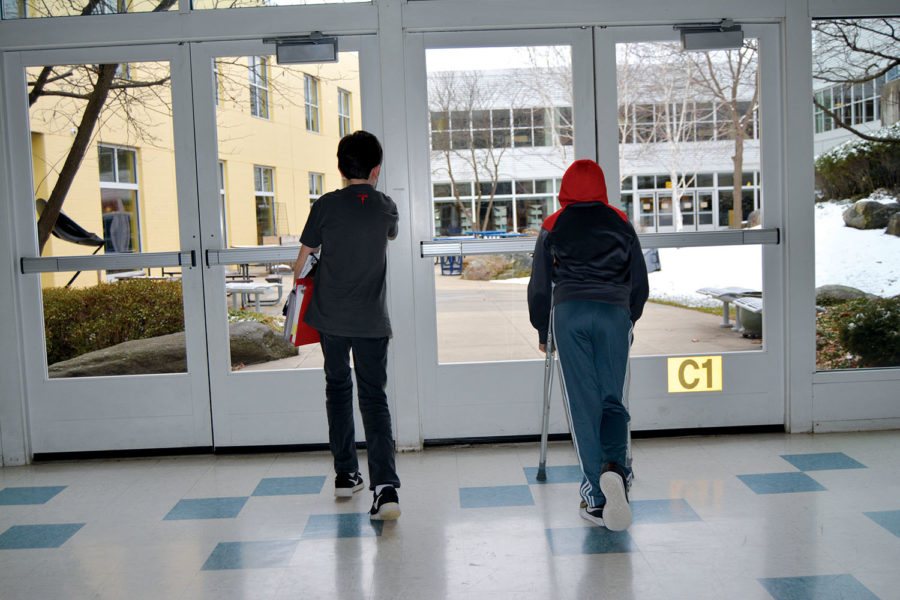Big Building Leads To Extra Pain: Getting Around BMS With A Cast
To help those on crutches, BMS has student helpers to carry binders.
Chances are we’ve probably seen someone in a cast or holding crutches, but do we really know what it’s like for them to go around school and do normal school things?
Evidently, it would seem more difficult to do regular school things, and it is.
“It slows you down, it just takes longer to do things,” said Mr. Arthur Ellis, one of the school’s STEM teachers. “They have to be let out early from class, or they could be late to next class,” he added, which reveals a major disadvantage these students have. Leaving early from class means that it’s possible to miss out on important directions or assignments from a teacher.
Despite all the troubles that ensue when wearing a cast, holding crutches or wearing a boot, it’s much better than what you would have to do without these advancements. “It’s very helpful, you use it instead of a wheelchair, which would’ve been the case 50 years ago,” said Mr. Ellis.
Given that perspective from a teacher, it’s also an issue affecting students, and they have a similar experience. “It’s so much harder to do stuff. To get here I had to go across the school, take the elevator and go across the school again,” described BMS student John Inglese, who was recalling his trip to the class he was in.
With all these challenges, BMS does have a way to make things a little easier: You will get paired with a student helper, who will help with holding your binders. Still, there are other suggestions. “There should be two elevators,” Inglese suggested.
However, that suggestion may never take shape, as there is no plan to have another elevator in the school, and it was planned with only one elevator in mind.
As you can see, having an injury can be a hassle, but remember that it’s better than what would be an even harder experience of being confined to a wheelchair.




Archie Lynch • Mar 6, 2018 at 8:41 am
I agree that it would be a good idea to have a student helper because it would make that persons life a lot easier to bring around his or her books
Lara • Feb 15, 2018 at 2:40 pm
I never thought about how long it would take to be in crutches going from one floor to another. This article has made me respect people with crutches even more. I even want to be one of the student helpers to help the other kids get around.
Dagny Dahl • Feb 15, 2018 at 12:30 pm
Wow this is really interesting, I have never been in a cast or crunches but know I know how hard it must be to get around class to class. I don’t even think I would ever survive! Nice Gob 🙂
CAITLIN JACOB • Feb 15, 2018 at 2:37 pm
It must be very hard for the people to get around. Thank goodness they d have someone to come with them.
CAITLIN JACOB • Feb 15, 2018 at 2:38 pm
check for grammatical errors
Ian • Feb 15, 2018 at 12:24 pm
you need to get two elevators because what is their is more than one kid. That has a cast it would be hard one than then the other
Everett Stickley • Feb 15, 2018 at 11:56 am
I never really thought about what it would be like to be in crutches or have a cast. And I agree that there should be two elevators
ruby kantor • Feb 15, 2018 at 10:48 am
If there are student helpers, then two people have to be late to class! I think they could be helpful but it might be a little hard because there most likely won’t be the one person in every single one of your classes.
Nina J • Feb 15, 2018 at 10:45 am
I like the article because it reminds me that you can be extra nice and help people who need it.
Tessa Cassell • Feb 15, 2018 at 10:26 am
I had never thought about what it was like to be in a cast in school. Trying to get to your classes on time, but at the same time trying not to miss out on any important information. This article made me realize and think about how even though our school has an elevator, it’s still very hard to get around the buildings. Thanks to reading this article; I will try to be more aware of the students and teachers in casts around me. I’ll try and help them in the hallways more by carrying their binders. Also if a friend in a cast ever asks me to help them get around school. I’ll be sure to help them get to class on time as fast as we can. I hope in the future more people will be aware of people in casts, and the struggles that come along with it. Hopefully that can lead to people in casts getting around the building faster, and missing less class time. (:
Emelie Engstrom • Feb 15, 2018 at 10:18 am
Really interesting article!
I liked it because it reminds you of how hard it must be for those students who are injured and makes you want to help them.
Tiffany Cheng • Feb 15, 2018 at 10:18 am
I agree with assigning student helpers. That way, those with crutches won’t have to struggle with carrying binders from class to class.